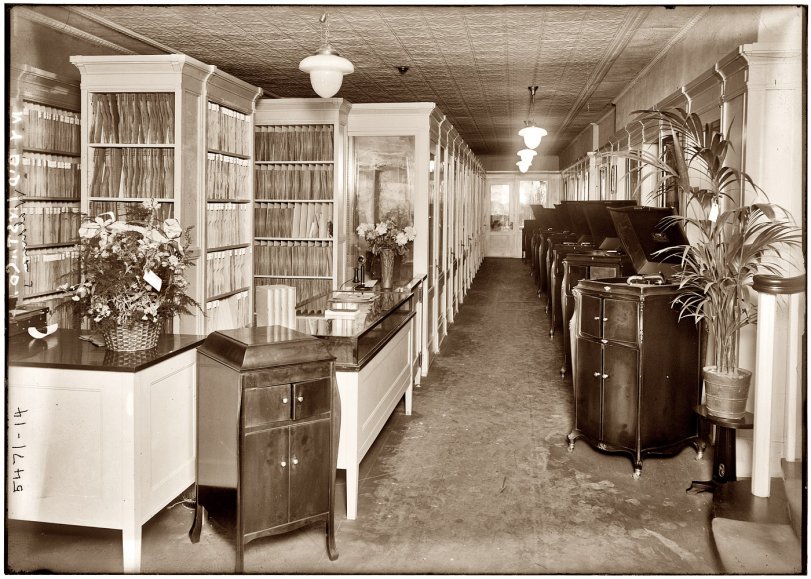


Framed or unframed, desk size to sofa size, printed by us in Arizona and Alabama since 2007. Explore now.
Shorpy is funded by you. Patreon contributors get an ad-free experience.
Learn more.

- Tough Guys
- Lost in Toyland
- And without gloves
- If I were a blindfolded time traveler
- Smoke Consumer Also Cooks
- Oh that stove!
- Possibly still there?
- What?!?
- $100 Reward
- Freeze Frame
- Texas Flyer wanted
- Just a Year Too Soon
- WWII -- Replacing men with women at the railroad crossing.
- Yes, Icing
- You kids drive me nuts!
- NOT An Easy Job
- I wonder
- Just add window boxes
- Icing Platform?
- Indiana Harbor Belt abides
- Freezing haze
- Corrections (for those who care)
- C&NW at Nelson
- Fallen Flags
- A dangerous job made worse
- Water Stop
- Passenger trains have right of way over freights?
- Coal
- Never ceases to amaze me.
- Still chuggin' (in model form)
Print Emporium
Waldman's Music: 1921

Another view of the Waldman's music store in Manhattan from 1921, showing records, listening booths and Victrolas. The inscription on the negative also says "N.Y. B'd Inst. Co." View full size. George Grantham Bain Collection.
The joy of music!
Waldman's is the spittin' image of the old Metro Music on 2nd Avenue in Manhattan, in the 1950s. Purchasing a phonograph record or sheet music was a big deal in those days. The salesman would demonstrate the record, or play the piece of music on a piano, "for your consideration." My uncle, who was in Yiddish theater, took me there regularly. Sometimes all of the salespeople would play a piece, as an ensemble, for the customer.
(I believe the floor is what was called oilcloth.)
Soundboxes
Note that none of the Victrolas (with lids open) have a soundbox attached to the tonearm. This was commonly done in large city stores, as soundboxes were easily shoplifted. For a demonstration, the salesman would produce a soundbox from behind the counter to play a record. The little VV-80 (in the foreground on the left) has a walnut finish (based on the grain pattern), which is somewhat unusual. Most of the lower cost models came in mahogany.
Floor fanatics
This was not a wood floor. It is early linoleum. Real Linoleum, which was sawdust, cork and linseed oil rolled together under pressure, dried out the more it was mopped. You have to re-oil them by putting down a coat of boiled linseed oil, wait for it to completely dry then paste wax and buff it. No varnish. Hard work.
You crazy modern noodnicks!
The Floor
It's a wooden floor in a busy and narrow business. On a rainy day you're likely to get quite a bit of mud tracked in even with paved streets. Having a person mopping up during business hours would probably be counterproductive - it blocks the passage to the back of the store and keeps people from examining the merchandise.
[I think what we're seeing is a combination of dirt and where the varnish has worn off. - Dave]
What I find fairly interesting is what looks to be the varying amount of traffic to the various listening booths. The heaviest traffic is clearly to the area behind the counter (access by staff to the records) but the "volume" of the footprints into the listening booths gets lighter and lighter as you get closer to the front of the store and away from the counter.
























On Shorpy:
Today’s Top 5